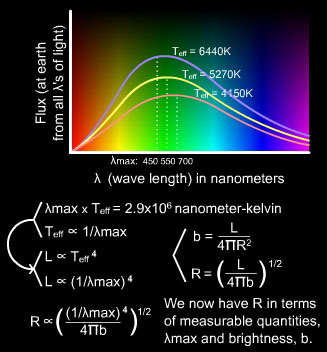Luminosity and Brightness

From Earth, we can only measure the brightness, b, of the Sun using telescopes since there is no way for us to get close to the surface of the Sun. From the previous slide, we know that we also have an equation which relates the distance (R), luminosity (L), and brightness (b). How can we use this information to find the luminosity, L, of the Sun?
It turns out that most stars are very close approximations to black bodies: black bodies have the special property that their surface temperature, Teff, and the wavelength, λmax at which they radiate their energy are related linearly. We can measure λmax with a telescope so we can also find the star's Teff.
What about L? It so happens that L is directly proportional to Teff4. The exact equation is too involved to be derived here, but this makes sense because the hotter the star (the higher the value of Teff) the larger the flux. And the larger the flux, the larger the luminosity. Essentially, this means that hotter stars are brighter, as we would expect.